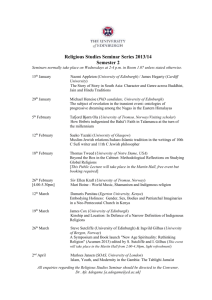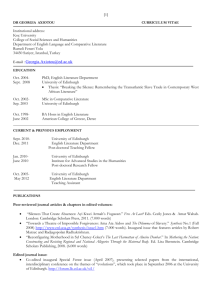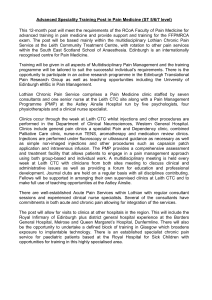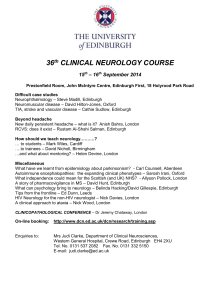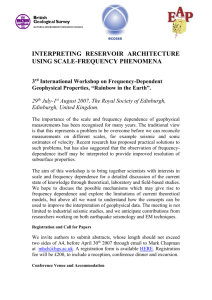pilrig_conservation_area_character_appraisal
advertisement
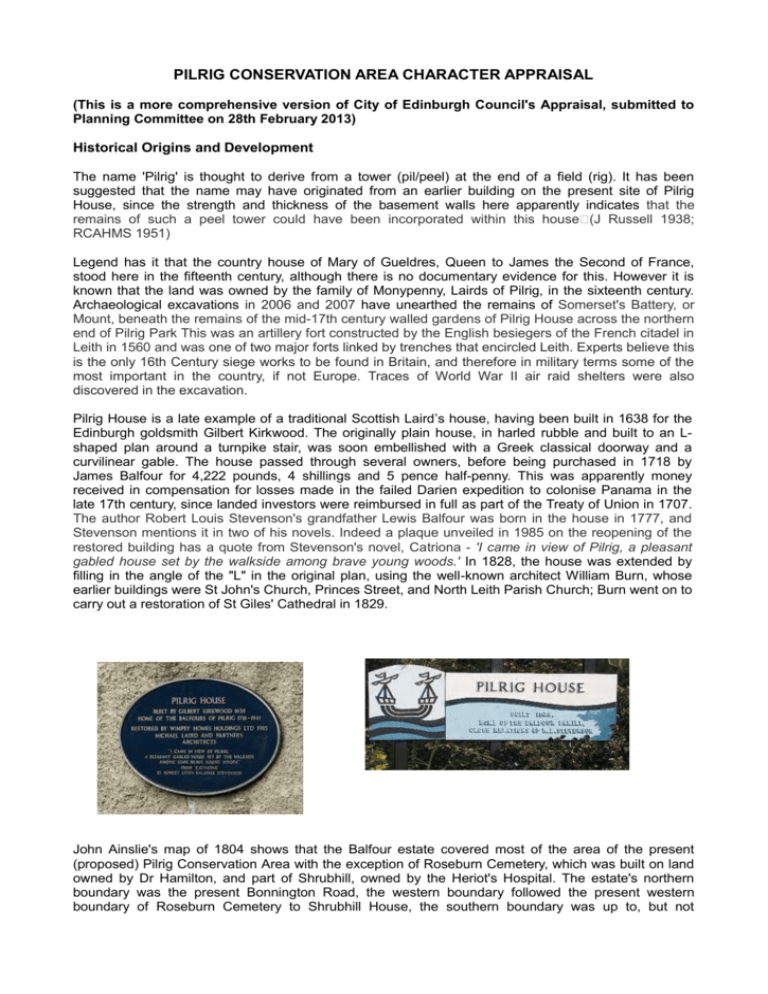
PILRIG CONSERVATION AREA CHARACTER APPRAISAL (This is a more comprehensive version of City of Edinburgh Council's Appraisal, submitted to Planning Committee on 28th February 2013) Historical Origins and Development The name 'Pilrig' is thought to derive from a tower (pil/peel) at the end of a field (rig). It has been suggested that the name may have originated from an earlier building on the present site of Pilrig House, since the strength and thickness of the basement walls here apparently indicates that the remains of such a peel tower could have been incorporated within this house (J Russell 1938; RCAHMS 1951) Legend has it that the country house of Mary of Gueldres, Queen to James the Second of France, stood here in the fifteenth century, although there is no documentary evidence for this. However it is known that the land was owned by the family of Monypenny, Lairds of Pilrig, in the sixteenth century. Archaeological excavations in 2006 and 2007 have unearthed the remains of Somerset's Battery, or Mount, beneath the remains of the mid-17th century walled gardens of Pilrig House across the northern end of Pilrig Park This was an artillery fort constructed by the English besiegers of the French citadel in Leith in 1560 and was one of two major forts linked by trenches that encircled Leith. Experts believe this is the only 16th Century siege works to be found in Britain, and therefore in military terms some of the most important in the country, if not Europe. Traces of World War II air raid shelters were also discovered in the excavation. Pilrig House is a late example of a traditional Scottish Laird’s house, having been built in 1638 for the Edinburgh goldsmith Gilbert Kirkwood. The originally plain house, in harled rubble and built to an Lshaped plan around a turnpike stair, was soon embellished with a Greek classical doorway and a curvilinear gable. The house passed through several owners, before being purchased in 1718 by James Balfour for 4,222 pounds, 4 shillings and 5 pence half-penny. This was apparently money received in compensation for losses made in the failed Darien expedition to colonise Panama in the late 17th century, since landed investors were reimbursed in full as part of the Treaty of Union in 1707. The author Robert Louis Stevenson's grandfather Lewis Balfour was born in the house in 1777, and Stevenson mentions it in two of his novels. Indeed a plaque unveiled in 1985 on the reopening of the restored building has a quote from Stevenson's novel, Catriona - 'I came in view of Pilrig, a pleasant gabled house set by the walkside among brave young woods.' In 1828, the house was extended by filling in the angle of the "L" in the original plan, using the well-known architect William Burn, whose earlier buildings were St John's Church, Princes Street, and North Leith Parish Church; Burn went on to carry out a restoration of St Giles' Cathedral in 1829. John Ainslie's map of 1804 shows that the Balfour estate covered most of the area of the present (proposed) Pilrig Conservation Area with the exception of Roseburn Cemetery, which was built on land owned by Dr Hamilton, and part of Shrubhill, owned by the Heriot's Hospital. The estate's northern boundary was the present Bonnington Road, the western boundary followed the present western boundary of Roseburn Cemetery to Shrubhill House, the southern boundary was up to, but not including, Middlefield and the buildings fronting Leith Walk, and the eastern side was roughly parallel to the western side, ending with the present Balfour Street, called on this map Pilrig Avenue. Pilrig Street , which formed the boundary between the burghs of Edinburgh and Leith, was marked here 'New Road from New Haven to Edinburgh'. Apart from Pilrig House, the few buildings shown on the estate in 1804 have not survived. AINSLIE'S 1804 -MAP SHOWING EXTENT OF BALFOUR ESTATE By the beginning of the 19th century, the expansion of both Edinburgh and Leith meant that house building was increasing in the Pilrig area. Kirkwood's 'Edinburgh and Environs' 1817 show the oldest terraced housing which line the Leith Walk end of Pilrig Street already built, plus a suggested plan for later additions. Although on this plan Arthur Street, Balfour Street and James Street (now Spey Terrace) follow their present street pattern, the map also shows three streets that were not built. These crossed and centered on Pilrig Street, and were called Melville Street, Whyte Street and St Cuthbert's Street. They were to be feued for detached houses, as was Arthur Street. However James Street appears to be have been laid out as terraced houses with individual gardens, similar to those already built on Pilrig Street, while Balfour Street was intended to have tenements. MAP Kirkwood's 'Edinburgh and Environs' 1817 If this plan had been developed, Pilrig might have grown to be one of the villa areas of Edinburgh such as Trinity and the Grange. However from 1825 onwards, there was a progressive decline in the rate of property development in Edinburgh and Leith as the financial crisis of 1825-6 deepened. This meant that there was now an oversupply of land which, although feued for building, remained undeveloped. Richard Rodger has explained that, from the mid 1820s, the amount of new property feued declined precipitously until another financial crisis in the mid 1840s had run its course (Rodger 2001, The Transformation of Edinburgh, pg 76) The history of building in Pilrig follows this pattern, so that the delay in speculative building and the growing industrialisation of the wider area around Pilrig may have affected plans that the area should become a middle-class suburb. Hence in the late 1840s, an area of the Balfour Estate at the furtherest distance from Pilrig House was feued for working-class rental housing. This was built by the Pilrig Model Dwellings Company, which had been formed in 1849 with the aim of building superior housing for the working classes. The scheme of 44 houses in four blocks was developed by architect Patrick Wilson, and built between 1849 and 1862. Originally known as the Pilrig Model Buildings, the streets were renamed in 1896 as Shaw's Street (the first to be completed in 1850), Shaw's Place and Shaw's Terrace. The blocks of this terraced housing were arranged so as to provide separate flats on ground and upper floors. These were approached from different sides of the building, so that the flats on the ground floor had their entrances on one side, while the stairs to the upper flats were on the opposite side. The flats were all self-contained, with not fewer than two rooms, a scullery, a closet, and gas and water supplies. All houses above the rent of £7 per annum possessed a water-closet; but for houses at £4 or £6 per annum there was only one water-closet for two or three families. Each flat had a small garden outside its front door. Although not found to be entirely satisfactory by their tenants, who complained about cold and draughts, the design was an important inspiration for later Edinburgh Co-operative Building Company Colony developments and the buildings were listed as Category B in 1999. In the same area, and in a further initiative to provide good quality housing for the working classes, the Edinburgh Artisan Building Company built a row of tenements on the opposite side of James Street (later Spey Terrace) in 1867. The small scale housing in the Pilrig Model Buildings was repeated when building began in nearby streets. The next area to be feued was land beside Arthur Street, where detached villas had been envisaged in 1817. Here a row of terraced cottage-style dwellings, called Pilrig Cottages, was built by Robert Simpson, mason, who retained Number 1 and advertised on 26th November 1862, Numbers 2,3,4 and 5 to sell or let as 'Now finishing, Private entrance from Arthur Street, Leith Walk. These Cottages have good Family Accommodation with Water Supply, Gas, Grates, W.-C., Flower Plot, and Right to Green' (Scotsman 26/11/1862). The allotment site still existing between the cottages and the present Cambridge Avenue is thought to date from the time when Pilrig Cottages were built and in 1933 twelve plots were registered here; there are now nine. The scale of building in these small and almost rural streets of Pilrig can be contrasted with the increasing industrialisation in the surrounding areas which were not part of the Balfour estate. In the 1850s and 1860s these developments began to affect the wooded setting of Pilrig House. Bonnington, a district to the north of Pilrig House began to change in character; the old cottages and nurserygardens were gradually superseded, and tenement blocks and factories began to fill the space between Bonnington Road and the Water of Leith. A distillery, and a particularly dominant 'huge red brick sugar work was built behind [Pilrig] House and .....about eighteen tenements built beside the old avenue which ran up to Leith walk; and, with regret, Mr Balfour saw that the hour had come when it was vain to stay the hand of the builder (The Balfours of Pilrig, Pg 306). The 'sugar work' was the 8 storey high Bonnington Sugar Refinery Company building, started in 1865. The opposite boundary of the Balfour estate had also become surrounded by building on neighbouring properties, and Johnson's Plan of Edinburgh and Leith of 1851 shows the Shotts Foundry built beside the Leith Walk end of the original driveway to Pilrig House. The main entrance to the house was now opposite the Edinburgh and Leith (later Roseburn) Cemetery on Pilrig Street. By 1868 the railways had arrived on the edge of Pilrig (built on the land owned by Heriot's Hospital) when a passenger station for the the Edinburgh, Leith and Newhaven railway line opened at Leith Walk. The then Laird, John Balfour now began the systematic feuing of more of his property. This involved the most easterly section, in the angle formed by Leith Walk and Pilrig Street, and in 1868 it was laid out in streets, and plans were drawn up for the guidance of feuars by the architect R Rowand Anderson, later well known for the Scottish National Portrait Gallery and other important Edinburgh buildings: "Anderson's launch into general practice began relatively inauspiciously with a Gothic tenement for John M Balfour in Balfour Street, Leith" (Dictionary of Scottish Architects). Anderson's elevations were said to have deliberately followed the old Scottish style of architecture of Pilrig House and thus preserved in the proposed new streets 'a certain resemblance to the ancient mansion which will probably ere long be elbowed out of its place. While reproducing the picturesque forms of a bygone age, the architect has shown no little skill in adapting those forms to the requirements of modern life' (Scotsman 16/6/1870 'Feuing at Pilrig'). This feuing plan had as the main artery the present Balfour Street, which followed the line of the old tree-lined avenue leading from Leith Walk to Pilrig House; the new street was to be about 75 feet wide and it was expected that it eventually would reach Bonnington Road. By 1878 there were thirteen tenements of working men's houses on the north side of Balfour Street and on the other some four or five, the feus to the south west remaining unoccupied (Scotsman 19/9/1878) Because Balfour intended that the remainder of the new housing should reflect that already built in the area, the aim was not to follow the main tenemental building form of Leith Walk but to keep intact the character of the existing self-contained houses already built, and provide houses for well-to-do artisans to purchase. Indeed it was said of Balfour: 'So various streets of little pleasant dwellings sprang up in the neighbourhood of Pilrig Street. He refused to make haste to be rich by accepting every bid for ground, and still clung to the old home when the good old days were past and the evil days were come upon it'.(The Balfours of Pilrig, Pg 306). From Balfour Street, three cross-streets 50ft wide (similar to the earlier feuing plan shown on Kirkwood 1817) were to be carried at right angles through the broad strip of ground between Balfour Street and Pilrig Street. The spaces between the cross streets were to be occupied by two main oblong blocks of dwelling houses plus several smaller blocks of houses were to fill up the angular spaces between Leith Walk, Balfour Street and the northern end of Arthur Street. However the layout of this plan was apparently amended, since in 1881 the land was feued to James Shaw for the erection of mainly two storey dwelling houses, with some flats at the Balfour Street corners. These are the terraces of Cambridge Avenue and Cambridge Gardens, and houses here were advertised in January 1886 as 'small self-contained dwelling houses, well built and carefully painted' at a price of between £300 for the corner flats and £500 for the houses. The rus in urbe qualities of the new streets was emphasised in the newspaper advertisement, the houses 'while being central and convenient combine all the amenity and quiet of country residence' (Scotsman 30/1/1886). This quality survives in Pilrig to the present, since as well as Pilrig Park and Roseburn Cemetery there are large areas of allotments behind Cambridge Gardens, with 33 plots, thought to date from the Second World War, and more allotments behind Pilrig Cottages (see above) There is also a recently designated Community Garden for Cambridge Gardens and Cambridge Avenue. The growing population in the area in the 1860s and 1870s meant that there was pressure on schools. The Balfour family took a particular interest in education, and Mrs. Balfour formed a committee to start a school at Bonnington Hall until the new Board School on the edge of the Balfour estate was completed. The Education Bill of 1872 put the care of the children under the School Boards, and Bonnington School was opened in 1875. Balfour was elected to be a member of the first Board, and the children of this school and that in James Street, which was connected with Pilrig Church, were invited each year to a strawberry feast at Pilrig House. (The Balfours of Pilrig, pg 247) Building on the Edinburgh side of Pilrig Street continued during the 1880s, first with Rosslyn Crescent and Rosslyn Street (1888). apparently named by the builder James Cowie, who was very fond of Roslin. The streets are shown on Johnstons' Plan of 1888 , the south side being incomplete. This development was followed by the building of two and three storey terraced houses along Pilrig Street, with 3 storey tenements at the corners of the cross streets such as Dryden Terrace. Building in the area continued after the First World War and in the 1930s a street of bungalows was built at Pilrig Crescent and modest two storey houses built in Dryden Gardens. Recently there has been a number of new blocks of flats built on infill sites in the area. However in the years following the First World War, the land nearest to Pilrig House remained undeveloped. Although the building here of working class housing by Edinburgh Corporation had been under consideration in 1921, it was decided instead to build the housing at Bangholm and reserve the Pilrig site for recreational use for the 'population of the congested area in its neighbourhood with Pilrig House'. (Scotsman11/1/1921). Indeed by the terms of the Extension Act of 1920, when Edinburgh and Leith were amalgamated, the Town Council was under an obligation to provide and maintain a public park in close proximity to the Leith district. In order to fulfil this commitment, a Minute of Sale was entered into between the Town Council and the owners of the Balfour Estate in 1922, so that twenty acres of the estate were acquired and developed for this purpose as Pilrig Park. Under this agreement the house and the gardens in its immediate vicinity (approximately 5.6 acres) were not to be transferred until the death of the last of the Balfour spinster sisters who lived there. The surviving sister, Miss Balfour-Melville, died in 1941 and the house was gifted to the Corporation of Edinburgh with the intention that it became a museum or a charitable institute, or for some other purpose, but on the condition that it was never to be let in apartments, divided into tenements or allowed it to fall into disrepair. It was subsequently used as a civil defence centre, a boys' club and a firemen's hostel and in 1946 provided emergency accommodation for ten homeless families. By 1954, the Corporation had no further use for the house and it stood empty except for a caretaker. Despite the undertaking to preserve the building, it gradually became uninhabitable, although its historical importance led to a Category A listing in 1966. After this the building continued to deteriorate and in 1971 and 1972 fires destroyed the roof and upper floors. The William Burn extension was demolished and the ruin of Pilrig House, with stone walls and crow-stepped gables remaining, dominated Pilrig Park for twelve years. The fortunes of the house improved in 1983 when, following an architectural competition, restoration was undertaken by Michael Laird Architects. The plan was to create six flats in Pilrig House, with sheltered housing built on adjoining ground behind the house, and to sell 1.8 acres of Pilrig Park for residential development (Wallace, 1997 'Traditions of Edinburgh and Leith'). Various 19th-century additions were removed to return the exterior to the original form of 1710 and the exterior and turnpike stair were restored to their original condition. Natural sandstone was used for all new masonry, even where it was to be covered with harling, and time was spent retrieving decorative stonework from the rubble left inside the shell. Copestones and skew putts to the curvilinear gable and the marriage lintel (with the initials of the original owner, Gilbert Kirkwood and his wife) were salvaged, cleaned and where possible returned to their original position. At the same time, the huge railway embankment for the Caledonian Railway, which used to enclose the park on its west and north sides, was flattened. This Caledonian (Goods) railway branch, which was built in 1903 from Newhaven to Leith Docks, used to run diagonally on an over-bridge across the intersection of Pilrig Street/Newhaven Road and Bonnington Road . The present warehouse here was built on top of the trackbed, flattened after the closure of the branch in 1968. The wall on the corner of Bonnington Road and Pilrig Street was a cutdown abutment to the bridge (Railscot). The railway track then ran close to the back of Pilrig House and diagonally across the present Pilrig Park. An earlier railway line, the Edinburgh, Leith and Newhaven Railway (later the North British Railway) was diverted from the Canal Street route to via Abbeyhill, and a passenger station opened at Leith Walk in 1868. This station was closed to passengers in 1930 but traces of the platform remain near Shrubhill, and a section of the 1868 connecting line from Powderhall to the East Coast Main Line is still in use to carry waste from the waste management plant at Powderhall to a landfill site in East Lothian. Apart from Pilrig Park and the allotments, the other large area of open ground in the Pilrig area is Rosebank Cemetery (previously the Edinburgh and Leith Cemetery) at the north end of Pilrig Street. This also has an interesting history since it was one of six cemeteries opened in Edinburgh between 1843 and 1847 (the others are Warriston, Dean, Newington, Dalry and Grange) by a number of speculative cemetery companies, in response to the need for more areas for burials on the (then) edge of Edinburgh. The cemetery that is now Rosebank was laid out by the Edinburgh and Leith Cemetery Company to a plan by David Cousin and opened 20th September 1846. As well as monuments to several minor historical figures, including the grave of Christian Salvesen and a tombstone erected by Queen Victoria to the memory of a maid who died in 1854 while accompanying the Queen on a visit to Edinburgh, the main historical interest here is the Gretna Memorial, erected in 1916 to those who died in the Quintinhill Rail disaster, the worst ever disaster to affect the Leith community. This occurred on 22nd May at Quintinhill near Gretna, and involved a south-bound troop train which crashed into a stationary local train and was then hit by the north-bound express. Two hundred and twenty six, passengers were killed, making this the highest death toll ever for a rail crash in Britain. The dead included 214 (mainly territorial volunteers) soldiers from the 7th Battalion, the Royal Scots, on their way to Gallipoli. These soldiers were known as the 'Leith Battalion' due to the large number who came from the area. Some of the bodies (107 of the dead, only 58 of whom were identifiable) were brought via Leith Central Station at Shrubhill to the Drill Hall in Dalmeny Street, which was used as the temporary mortuary. A funeral service was held there (the Scotsman reported that painful and heartrending scenes were witnessed) followed by a funeral procession down Pilrig Street, lined with crowds of people who had come to pay their respects, to Rosebank, where most were buried in a mass grave. A plaque on the gates of the cemetery wrongly gives the date of the disaster as 1916 Shrubhill, the main industrial site in the Pilrig area, is now cleared for re-development, with the exception of the the three red brick buildings at the Dryden Street end. These are the former Shrubhill Tramway Workshops and Power Station, which are category B listed and were intended to be incorporated into new housing developments planned for the site before the recession. Only part of this area was included in the Balfour estate and an early use was as a place of execution: 'a permanent gibbet at the Gallow Lee, a dreary object to the wayfarer by night, when two or three malefactors swung there in chains, with the gleds and crows perching over them' (Cassell's Old and New Edinburgh, Vol 5, pg 154). The ground here was also extensively quarried for mortar sand to be used in the building of the New Town of Edinburgh, and it was said that this sand for this purpose came mixed with the remains of the criminals who had been executed and buried on the site. Later Shrub House, a small country house and gardens, first shown on Ainslie’s 1804 plan of Edinburgh, was built on the property of Captain Maxwell, but the house and its gardens were quickly surrounded by subsequent industrial developments. A Tramway Stores and Stables and a Marble Works are shown on Johnstons' plan of 1888, but Industrial building here dates back to 1871 with the construction of the workshop for the Edinburgh Street Tramways, a horse-drawn tramway company: the first tram to be built entirely in the Shrubhill works was finished in May 1879. The building survived until the 1890s when it was demolished during the expansion of the Tramway works. Due to the hilly nature of Edinburgh, it was decided that a better form of public transport was required, and in 1893 Edinburgh Corporation received an agreement to replace all the horse tram routes by cable routes; this was similar to the system used in San Francisco. The first tram route to use the cable system dated from 1888, and the Shrubhill Tramway Workshops and Power Station opened in 1898. The Power Station housed the haulage engines for cable-tramway operations,.and by the end of 1900 practically all of the 21.25 miles of tram routes in the city had been converted to cable operation. This was a different system to that used in Leith, which had had electrified trams since 1905. Pilrig was the point where passengers going from Edinburgh to Leith had to change trams from Leith's electrified tram system to Edinburgh's cable tram system. This inconvenience was known as the "Pilrig Muddle" and existed until Edinburgh's cable cars in Leith walk were replaced by electric trams in June 1922, allowing a through journey between Edinburgh and Leith. In 1952 a programme began to replace the entire tramway fleet with motor buses and the last of the old trams ran in November 1956. The tramway workshops were used until recently as a garage for Lothian Buses. However the planned development of the gapsites in the Pilrig area, following the demolition of most of the buildings on the Shrubhill site and the eventual demolition of the former Social Work HQ at Shrubhill house, has been halted by a combination of the recession and uncertainty about the final destination of the new tramline. It can be seen that the main historical interest of the Pilrig area lies in the fact that, with the exception of Roseburn Cemetery and some of Shrubhill, all the land in the area was owned and, most importantly, lived on, in the same house, by members of the Balfour family over a 223 year period. Their initial decision to feu land for the Pilrig Model Buildings (following a period from 1820-1850 when little housing for sale was built) was important for the spatial development of the area since this was followed by the building of a high proportion of small and medium sized terraced housing, unusual so near the centre of Edinburgh. Pilrig contains a high proportion of green space in Pilrig Park and Roseburn Cemetery but it also has an interesting industrial history with the main areas centered around Shrubhill and to the east of Balfour Street. It is the scale of the housing and the contrast between green space and industrial heritage that gives the Pilrig area today its unique charm and character. Analysis and Essential Character Spatial Structure and Townscape The (proposed) Pilrig Conservation Area lies midway between Edinburgh and Leith and is intersected by Pilrig Street, which formed the historical boundary between the two burghs. In spite of the fact that the area was governed by different town councils until 1920, when Edinburgh and Leith were amalgamated, the layout of the area reflects a long history as a coherent entity, since the area covered by the present proposal was originally (in the main) one estate owned by the Balfour family. Thus its development over nearly three centuries reflects the wider development of Edinburgh and Leith, but also decisions made by individuals from one family over time. The area is situated on the gentle slope down to Newhaven and Leith, with the large area of open space of Pilrig Park and Rosebank Cemetery in the northern half, and most of the housing and former industrial development in the south. This reflects the fact that Pilrig House lies in the most northernly part of the area, and the Balfour family, in an effort to preserve the rural setting of the house for as long as possible, began to first feu land for housing development near to the furthermost Leith Walk boundary. Therefore the area was not planned as a whole but developed incrementally as land nearer to Pilrig House began to be feued, and the spatial structure is characterised by varied street patterns and different scales of the mainly terraced housing, built from the early nineteenth century until the 1930s, and also infill modern flats. The area is relatively low in density, given its proximity to central Edinburgh, and although there are some streets, such as Balfour Street and Dryden Place/Spey Street which follow the traditional tenemental scale of Leith Walk, other streets consist mainly of stone-built terraced housing. The larger houses are along Pilrig Street, with the early 19th century housing at the southern end of the street and infill Victorian (and Edwardian for the red sandstone houses?) towards the north. Pilrig Street is built up on the western side, with the houses having a pleasant open view over Pilrig Park. The cross streets, as a contrast to this, have a sense of enclosure, with speculatively built small-scale housing for skilled artisans and lower middle class owner occupation. At an even smaller scale, some of the streets that were built in the mid 19th century for rental are virtually urban cottages. Even Rosslyn Cresent which includes more tenements and large villa flats, has a sense of enclosure, being built round a narrow communal garden. (Also 1930s bungalows in Pilrig Gardens - still unmade road - and Dryden Gardens, etc?). The fact that area has a spectrum of housing from rather grand terraced housing through small terraced housing for the better off artisans to urban cottages and small flats has led to an unusually high level of social mix in the area. MAP (TOWNSCAPE AND SPATIAL STRUCTURE) Vistas The area contains two of the key protected views across Edinburgh to Calton Hill, that is first (N5a) from the North-East corner of Pilrig Park and from Pilrig Street, near Bonnington Road and Pilrig House, both to Calton Hill, and second (N5b) a view of Nelson's Monument and the National Monument from the North corner of Pilrig Park and also, from the centre of the park, a particularly fine view of these monuments, the City Observatory and the open sky space beyond Calton Hill. Cutting through the area, the view down Pilrig Street towards the green space of Pilrig Park (which is bordered along the Pilrig Street side by a strip of community woodland) is very attractive, as is the view down tree-lined Balfour Street to Pilrig House. For those who appreciate our industrial heritage, the views over the (mainly) cleared Shrubhill site and through the tram sheds on Dryden Street have a haunting beauty. Architectural Character Unlike the 19th century villa areas of Edinburgh and Leith that have their architectural coherence as a main attribute, Pilrig's architecture reveals the diversity and unique richness of its pre-industrial, industrial and now post-industrial history. The historical section (above) has already dealt with this in sequence, so this section will look at the current architecture of both the listed buildings and the street types in the area. The (proposed) Conservation Area has a total of 49 listed buildings, including groups of listings such as Shaw's Colonies, the Shrubhill Tramway Workshops and Power Station, and Rosebank Cemetery. The earliest surviving buildings dates from 1638, and the area also contains work by well known 19th century architects William Burns and Robert Rowand Anderson. The key building in the area is undoubtedly Pilrig House which has been sensitively restored by Michael Laird & Partners in 1984-5 in line with the original 3-storey and attic L-plan tower house. The walls have been rebuilt in rubble, with polished cream sandstone dressings, and then harled. Aspects of the house, for example the crowstepped gables, were recognised as an influence on other buildings in the area, particular some of the Balfour Street tenements. The main (south-east) elevation overlooking Pilrig Park has a 3-bay elevation with the centre bay having a (circa 1700) curvilinear gable, reflecting the influence of Dutch or Flemish architecture. The early 19th century columned doorway at first floor level is accessed by stone stairs with carved steps, panelled door and fanlight with astragals of 4 trefoiled arches. Single windows flank the stairs at ground floor and there are two single windows at second floor level with a bull's-eye window to the gable head. There is a modern, square, wall-mounted sundial to outer left at second floor level, over carved armorial stone with angel heads. Bonnington School (listed CS in 1995) was designed by James Simpson in 1875, with additions signed and dated by George Craig in1907. It is a large two -storey T-plan school, built in cream sandstone with gothic details, together with a detached single storey janitors house and play shelters. The rear block has a narrow linking section and separate doorways inscribed 'Girls' Entrance' (NE) and 'Boys' Entrance'(SW) to each side of the link. This building is currently being renovated for use as the Gaelic Primary School for Edinburgh Rosebank Cemetery (Listed B in 1999) was laid out as a garden cemetery by the then City Architect, David Cousin and opened on the 20th September 1846, it has sandstone rubble coped and stepped boundary walls enclosing and dividing the site. The headstones are predominantly later 19th century, with several column memorials (with urns surmounting some). There is a central walled pend to the middle of the site and some gravestones are now set in the boundary wall, The Gretna war memorial is on a granite plinth to the south-east of and there is also notable pink sandstone gothic memorial, 1911, to Christian Salveson. The Pilrig Model Buildings (now Shaw's Colonies at nos 1-28 Shaw's Street, 1-10 Shaw's Place and 118 Shaw's Terrace) is an historically influential example of model working class housing. Designed by Patrick Wilson for the Pilrig Model Dwelling Company, the buildings are arranged in four 2-storey blocks build round a central court. The north-east and south-west blocks were built first, followed by the southeast and north-west blocks (dated 1862). The houses were built in squared and snecked sandstone rubble with ashlar margins. The north-east block (1-7 and 8-14 Shaw's Street) has architraved doorpieces with fanlights, and the end houses have pedimented gable fronts. Although the buildings have suffered alterations to doors and windows, the unbroken roof line, 4 bar dormers, survival of chimney stacks and unaltered openings enabled them to be listed B in 1999. In Shaw's Terrace there is a through pend with keystones dated 1862 on both sides of the pend. The whinchip paving has survived. Shaw's Colonies faces a contrasting model housing initiative, namely tenement housing built in James Street (now Spey Terrace) by the Edinburgh Artisan Building Company in 1867. This has minimal classical detail and the monogram of the building company and date can be seen above the door to number 29. Pilrig Street contains a mixture of early and late 19th century terraced housing with the earlier houses (predating 1830) on both sides, from the junction with Leith Walk to near Dryden Street, included in the Leith Conservation Area. Later houses, opposite Pilrig Park, are mainly built of red sandstone with tenement flats at the corners of the cross streets. The grandest house is Number 94 Pilrig Street (B listed) which dates from 1857. This 2-storey, 3-bay, villa has Scottish 17th Century details such as the projecting crow stepped gables and decorative arrow slits over the windows. The arched doorway has a date panel below the pediment. Rosslyn Crescent/Street: 'Buildings of Edinburgh' describes this development as 'a bottle-shaped development of middle class houses opening direct from Pilrig Street. At the entry, four semi-detached houses with rustic dormers; then two serpentine two storey terraces with bay windows, enclosing trees and leading to a three-storey block with copious bays and a couple of slated hats, startlingly upright'. Cambridge Gardens is a narrow street of mansard roofed, small-scale terraced housing built in a pattern of alternating 2 window and 3 window bay projections. The, slightly later, Cambridge Avenue is on a similar scale but here wooden cross-bracing in the roofline apex of front facades and the surviving finials and cross astragal windows show the Arts and Crafts influence. Both these streets end in flatted villas on the corners to Balfour Street. Balfour Street itself was begun by R Rowand Anderson in 1868. It consists of rubble tenements with Gothic detail at Nos 36-38, where the chimneys are corbellled out from the wall. The surviving remains of the industrial develoment at Shrub Place, Shrubhill Tramway Workshops and Power Station are B-listed, and on the 'Buildings at Risk' Register. Here certain buildings and structures have a particular historic and architectural interest. These include the early tramway workshops and power station and later brick tram sheds located to the north of the site, adjacent to Dryden Street. The oldest buildings were built in 1898 and extended out later, probably in the 1920s.The original buildings are red brick with sandstone bands and have a number of interesting features, such as large round arched recessed openings, shaped pediments circular windows. Internally, there is a grand painted brick interior with recesses through from the exterior arches and an exposed steel roof construction with a clerestory band. The chimney is included in the listing, although it was reduced in height around 1975. The gabled retaining wall to Shaw's Colonies has been preserved intact after demolition of the tram works. Natural Heritage The area has a high proportion of green space for one so near to the centre of Edinburgh. Pilrig Park in particular has many mature trees and a community woodland along the boundary wall with Pilrig Street. Similarly, Roseburn Cemetery...................., Also, in keeping with the distinctive urban cottage building form in the vicinity, there is a large allotment areas (33 plots) between Pilrig Park and Cambridge Gardens and a smaller area (9 plots) behind Cambridge Avenue. The Cambridge Community Garden is at the western end of Cambridge Gardens. The small scale of several of the streets in Pilrig mean that front gardens remain as gardens and have not been used as run-ins for cars. Balfour Street has trees planted on either side, reflecting its earlier history as a tree-lined route to Pilrig House. Activities and Uses The main retail spaces in the area are on Leith Walk, with further small shops for daily needs on the corners of Dryden Street/Spey Terrace and Balfour Street/Cambridge Avenue. The industry remaining in the area is small-scale, for example car repairs premises on Arthur Street and small workshops in Spey Street and the mews lane. One of the earliest group of immigrants to the area were the economic migrants from the Northern Isles. The establish of this community lead to the formation of the Edinburgh and District Shetland Association in 1928. In 1962 Glendinings' Ballroom at 11 Pilrig Street was purchased as a headquarters and renamed the Zetland Hall. Although this was sold in 1983 the heritage lives on in the fiddle classes for local children held in the hall of Pilrig Church and the designation of the (former) Bonnington School as the new Gaelic primary school for Edinburgh. More recent immigrants include Asian, Chinese and latterly Poles; for several years the Mela was held in Pilrig Park. Shops and cafes on Leith Walk reflect the multicultural nature of the area, For more information contact: Annette O'Carroll 13 Cambridge Gardens Edinburgh EH6 5DH 0131 5555210 aocarroll2006@yahoo.co.uk

